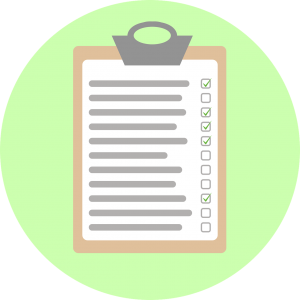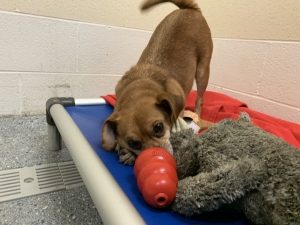Ask Crystal: Separation Anxiety
Welcome to “Ask Crystal,” where you can ask your pet behavior questions! You can submit your question for Crystal at the bottom of the page!
 Dear Crystal,
Dear Crystal,
Do you have any helpful hints in regards to separation anxiety? My sweet little dog is doing well with staying in a room by herself while I do something quick in another room. However, she prefers to stay where she can see me. I know this will take time and it is very good that I currently work from home. But I need to have her ready and prepared for the day I will have to return to the office.
Sincerely,
Working Mom
Dear Working,
I am so glad you are thinking about prevention now while your dog is still new to your home. Dogs with separation related behavior problems engage in undesirable stress behaviors when left alone. The most common being destructive behaviors and excessive vocalizations. Other less common problems are house soiling, self-injurious behavior, attempts to escape, trembling, salivation and depression. Separation anxiety is really difficult to live with and treat so it is really important to spend time to prevent the issue from ever developing.
Dogs adopted from shelters tend to have a higher risk of developing separation anxiety so it is time well spent to work on prevention. Dogs that are especially clingy are at a high risk for separation anxiety and dogs that are anxious in general are more likely to develop it.
Teach your dog to stay in a crate or pen now while you are still working from home. It is the perfect time to teach it because you don’t have to leave her in it for too long of a period of time yet. That is one of the most common mistakes people seem to make is leaving the dog in the crate before they have been properly acclimated. I also incorporate the phrase “I will be back” into the training process. The dog hears the phrase and knows you won’t be gone forever.
One of the things that works for me with crate training is having a couple crates. I put one in the bedroom and the other in a room that I spend a lot of time in. I do this because I can teach the dog that being in the crate is not only about being alone. Sometimes she sits in her crate when I need to eat or have a break. This avoids the negative association of crate means being left alone. It helps to create a more positive association so that she doesn’t mind being in there when you do need to leave.
 Create a daily routine for your dog. Routines and knowing what comes next really helps to ease some of the anxiety dogs are feeling. While you are going to have to switch up the routine when you have to go back into the office, you can start creating a routine which is moving towards what it will eventually be.
Create a daily routine for your dog. Routines and knowing what comes next really helps to ease some of the anxiety dogs are feeling. While you are going to have to switch up the routine when you have to go back into the office, you can start creating a routine which is moving towards what it will eventually be.
Allow your dog and yourself some alone time now. I know it seems strange if you are working from home but it is pretty important. There needs to be regular times throughout the day when she is alone while you are home. You can use a baby gate to confine her to a bedroom if you aren’t crating. Otherwise, you can put her in a crate, x-pen or shut the door to the room you are in. Start off with very short time periods at first and gradually build up the time left alone.
You also need to actually leave the house at least three days a week. Ideally, it should be a gradual process of using short absences to teach the dog that they are safe when you leave and that you will come back. Start by walking to the mailbox or around the block. Then run errands like going on short shopping trips. You can take a longer walk or sit outside and read a book for an hour or so as you build up the time.
Consider purchasing an inexpensive webcam so you can observe your dog’s reaction and make sure they are not panicking when you leave them alone. If you dog is showing signs of extreme stress like drooling, panting, scratching up doors, being destructive and having accident, consult a Certified Professional Behavior Consult to begin working on a training protocol now before the behavior becomes worse. You can locate one here.
 Teach your dog to love food enrichment toys. You can start out with really easy toys like a kong stuffed with her daily food allotment though out the day so that you aren’t overfeeding. Mix in can food, wet the food down with water or top with peanut butter to entice her. Eventually when the dog gets really good at them, you can freeze them to extend the time they last. The dog will need to lick the food out. The act of licking is soothing to dogs so we can teach them to self soothe by offering licking food toys every time we leave them alone. I would suggest starting by giving the toys while you are there so she will get into eating it. Offer her a small one every time you put her in her quiet zone or leave her alone. A lot of people save special treats for only when the dog is alone.
Teach your dog to love food enrichment toys. You can start out with really easy toys like a kong stuffed with her daily food allotment though out the day so that you aren’t overfeeding. Mix in can food, wet the food down with water or top with peanut butter to entice her. Eventually when the dog gets really good at them, you can freeze them to extend the time they last. The dog will need to lick the food out. The act of licking is soothing to dogs so we can teach them to self soothe by offering licking food toys every time we leave them alone. I would suggest starting by giving the toys while you are there so she will get into eating it. Offer her a small one every time you put her in her quiet zone or leave her alone. A lot of people save special treats for only when the dog is alone.
If your dog is not going to be crated when you leave, you can teach her to find hidden treats around the house now. Then when she does need to be left all day, she can spend some time searching for treats which is a fun and enriching game. It engages the dog’s nose which is relaxing and tires them out.
Exercise and enrichment are really helpful for preventing and relieving anxiety. Give her a walk or exercise her before you leave. Play a game of fetch or tug if you don’t have time for a walk.
Keep your arrival and departure routine low key. Don’t make a huge fuss telling the dog how much you will miss them when you leave. When you come home, walk in and put your things down and then walk around for a couple minutes and acknowledge the dog with a calm pet once she has calmed down. You may want to leave her with an item of your clothing that smells like you to soothe her.
Hopefully, if you begin gradually introducing short increments of separation you can build up the amount of time, she can get used to being alone in a positive way. That way it won’t be so difficult to transition to a different routine. If you anticipate having to work really long days, you may also consider some options for her such as: hiring a dog walker or neighbor to come walk her midday, doggie day care once or twice a week.
Until next time,
Crystal







